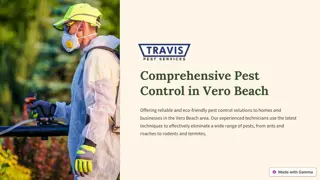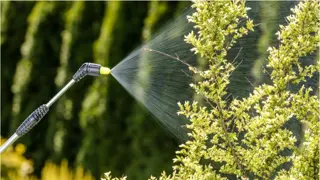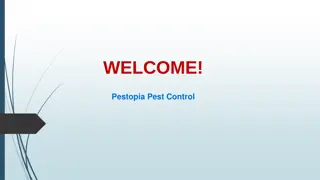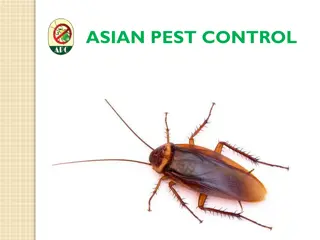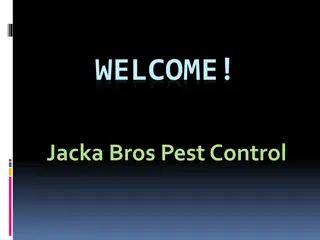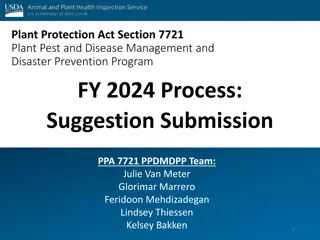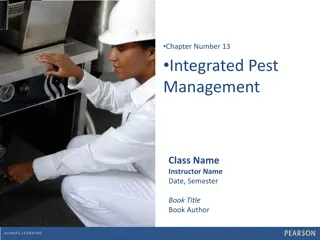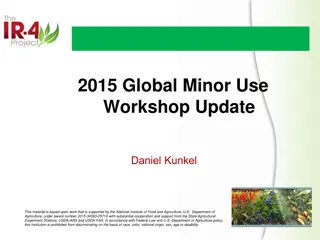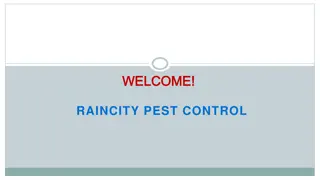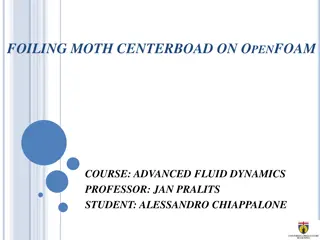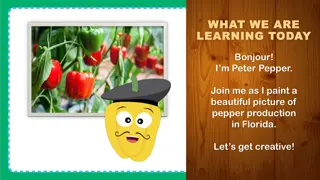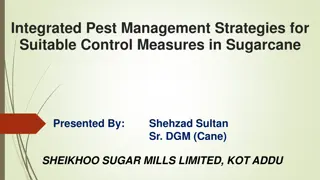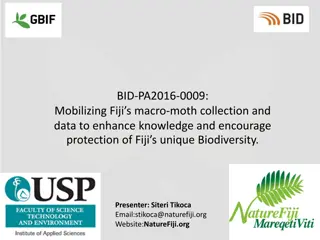European Pepper Moth: A New Emerging Pest in Florida
The European Pepper Moth, native to coastal wetlands of the Mediterranean, has become a concern in Florida as a potential pest affecting various ornamental and agricultural plants. Its distribution in Florida is still being monitored, and it poses a threat to a range of susceptible plant species. This pest can be identified through its eggs, larvae, pupae, and adult stages, making it important for early detection and management strategies.
Download Presentation

Please find below an Image/Link to download the presentation.
The content on the website is provided AS IS for your information and personal use only. It may not be sold, licensed, or shared on other websites without obtaining consent from the author.If you encounter any issues during the download, it is possible that the publisher has removed the file from their server.
You are allowed to download the files provided on this website for personal or commercial use, subject to the condition that they are used lawfully. All files are the property of their respective owners.
The content on the website is provided AS IS for your information and personal use only. It may not be sold, licensed, or shared on other websites without obtaining consent from the author.
E N D
Presentation Transcript
A New Emerging Pest in Florida: European Pepper Moth (Duponchelia fovealis) Photo: Carmelo Peter Bonsignore, Universit degli Studi Mediterranei di Reggio Calabria
European Pepper Moth Native to the coastal wetlands of the Mediterranean. A.k.a. Southern European marshland pyralid and European Pepper Moth . Is known as a greenhouse pest in Northern Europe. May become a pest outside of a greenhouse setting if the climate is right.
Known Distribution in Florida No sampling Sampled but not found Intercepted or detected, but not considered established Map based on CAPS Survey September 2010 to May 2011, research conducted by S. Stocks, and NAPIS Pest Tracker.
Susceptible Plants Ornamental hosts include: Begonia Daisies Poinsettia Lisianthus Common purslane Creeping buttercup Cyclamen Impatiens Kalanchoe Coral bells Agricultural hosts include: beet pepper fig basil pomegranate blackberry Tomato Cucumbers Squash Strawberries There are several aquatic plants hosts as well.
Identification Eggs Laid singly or in groups of 3-10. Mostly found on undersides of leaves can also be found on the upper side of the leaves, on the stems, at the base of the plant, in the upper soil layer. Larvae Turn creamy white or light brown with spots as they mature. Depending on diet 20-30mm long when fully developed. Color of larvae feeding on live plant material Photos: Eggs - Carmelo Peter Bonsignore, Universit degli Studi Mediterranei di Reggio Calabria and Pasquale Trematerra, University of Molise, Italy. Larvae - Henk Stigter, Plant Protection Service, National Reference Centre, The Netherlands, Marja van der Straten, Plant Protection Service, Wageningen, Netherlands, and Lyle Buss, Department of Entomology and Nematology, University of Florida Color of larvae feeding on detritus
Identification Pupae 9-12mm long made of webbing with soil and frass in it. Found on undersides of leaves, at the edge of the pot, or in the upper soil layer. Adults 19-21mm across Striped abdomen Dark wings The finger male male female Photos: Pupa - Henk Stigter, Plant Protection Service, National Reference Centre, Netherlands and James Hayden, Florida Department of Agriculture and Consumer Services, Division of Plant Industry Adult - James Hayden, Florida Department of Agriculture and Consumer Services, Division of Plant Industry and Carmelo Peter Bonsignore, Universit degli Studi Mediterranei di Reggio Calabria
Life Cycle Egg stage ( 4-9 days) Adult Laval stage (3-4 weeks) (1-2 weeks) Photos: Carmelo Peter Bonsignore, Universit degli Studi Mediterranei di Reggio Calabria Pupal stage (1-2 weeks)
Hibernation and Dispersal Is not cold tolerant. Hibernation reportings are unknown In colder climates: it is primarily a pest of greenhouses. In warmer climates: it is usually found in the field Dispersal: Movement of plant material spreads this pest They are also reportedly good fliers
Damage to leaves Damage to fruit Strawberry Eustoma Pepper Damage to stems Image credits: Strawberry - Carmelo Peter Bonsignore, Universit degli Studi Mediterranei di Reggio Calabria; Pepper fruit - Marja van der Straten, Plant Protection Service, Wageningen, The Netherlands; Stem damage - Bryan Vander Mey, Department of Entomology, University of California, Riverside; Both Eustoma images - Henk Stigter, Plant Protection Service, National Reference Centre, The Netherlands Note the larva girdling the stem Stem collapse in Eustoma
Monitoring and Inspection Check pots next to detritus Plant pulled out of the container Check the bottom edge of the container. Look for webbing on the soil surface adult Photos: Lyle Buss, Department of Entomology and Nematology, University of Florida
Florida Look Alikes - Adults Hydriris ornatalis Niphograpta albiguttalis Udea rubigalis Parapoynx obscuralis Penestola bufalis Duponchelia fovealis Image credit: James Hayden, Florida Department of Agriculture and Consumer Services, Division of Plant Industry and Thomson Paris, graduate student, Department of Entomology and Nematology, University of Florida; EPM - Kurt Ahlmark, FDACS Division of Plant Industry, Bugwood.org - #5499609
Authors Stephanie Stocks, M.S. Assistant-In, Extension Scientist, Department of Entomology and Nematology, University of Florida Amanda Hodges, Ph.D. Associate Extension Scientist, Department of Entomology and Nematology, University of Florida
Editors Matthew D. Smith, Ph.D. Postdoctoral Associate, Department of Entomology and Nematology, University of Florida Keumchul Shin, M.S. Graduate student, Doctor of Plant medicine program, University of Florida
Reviewers Douglas A. Restom Gaskill, M.S. United States Department of Agriculture, Animal and Plant Health Inspection Service, Plant Health, Plant Protection and Quarantine, Cooperative Agricultural Pest Survey Jim Hayden, Ph.D. Florida Department of Agriculture and Consumer Services, Division of Plant Industry Jason Dombroskie, Ph.D. Senior Extension Associate, Department of Entomology, Cornell University
Collaborating Agencies U.S. Department of Agriculture Animal and Plant Health Inspection Service (USDA-APHIS) Cooperative Agricultural Pest Survey Program (CAPS) Florida Department of Agriculture and Consumer Services (FDACS) National Plant Diagnostic Network (NPDN) Sentinel Plant Network (SPN) Protect U.S. University of Florida Institute of Food and Agricultural Sciences (UF-IFAS)
Educational Disclaimer and Citation This presentation can be used for educational purposes for NON-PROFIT workshops, trainings, etc. Citation: Stocks, S., M.S., Hodges, A., Ph.D., 2014. A New Emerging Pest in Florida: European Pepper Moth (Duponchelia fovealis) March 2014.
References Ahern, R. 2010. Amended NPAG Report. Duponchelia fovealis Zeller: Lepidoptera/Pyralidae. Accessed 4/29/2011 - http://entnemdept.ufl.edu/pestalert/Duponchelia_fovealis_NPAG_ET_Report_20100917.pdf Anonymous. 2005a. Risk management Decision Document for Duponchelia fovealis in Canada. Canadian Food Inspection Agency. Accessed 4/29/2011 http://entnemdept.ufl.edu/pestalert/duponchelia_fovealis_risk_management.pdf Anonymous. 2005b. Plant Pest Information: Duponchelia fovealis Zeller. Canadian Food Inspection Agency. Accessed 4/29/2011 - http://entnemdept.ufl.edu/pestalert/Duponchelia_fovealis_Canada.pdf Bethke, J. and B. Vander Mey. Pest Alert: Duponchelia fovealis. University of California Cooperative Extension, San Diego. Accessed 4/29/2011 http://ucanr.org/sites/cetest/files/55177.pdf Billen W. 1994. On the harmfulness of Duponchelia fovealis (Zeller, 1847) in Germany (Lepidoptera, Pyralidae). Nota Lepidopterol, 16: 3-4, p. 212. Bonsignore, C. P. and V. Vacante. 2010. Duponchelia fovealis (Zeller). A New Emergency for Strawberries? . Protezione delle colture, pp. 40-43.
References Brambila, J. and I. Stocks. 2010. The European Pepper Moth, Duponchelia fovealis Zeller (Lepidoptera: Crambidae), a Mediterranean Pest Moth Discovered in Central Florida. Accessed 4/29/2011 http://www.freshfromflorida.com/pi/pest_alerts/pdf/duponchelia_fovealis.pdf CABI International. 2010. Selected Sections for: Duponchelia fovealis (Southern European Marshland Pyralid) . Crop Protection Compendium. Clark, J. S. 2000. Duponchelia fovealis (Zell.) arriving on imported plant material. Atropos 10:20 21. Derksen, A., and L. Whilby. 2011. Update on Florida CAPS trapping activities for Duponchelia fovealisZeller, September 2010 to May 2011 , CAPS Report. http://entomology.ifas.ufl.edu/stocks/DFOV_update%201_v5%2008-19-11.pdf DeVenter, P. van. 2009. Water trap best for catching Duponchelia . Fruit & Veg Tech 9.1. Accessed 4/29/2011 - http://documents.plant.wur.nl/wurglas/C_bestwatertrap.pdf
References Faquaet, M. 2000. Duponchelia fovealis, een nieuwe soort voor de Belgische fauna (Lepidoptera: Pyralidae) . Phegea 28:1. Guda, C. D. , A. Capizzi, and P. Trematerra. 1988. Damages on Eustoma grandiflorum (Raf.) Shinn. caused by Duponchelia fovealis (Zeller) . Annali dell Istituto Sperimentale per la Floricultura. Vol. 19, pp. 3-11. Hale, W.G. and J.P. Margham. 1991. The Harper Collins Dictionary of Biology. Harper Perennial, New York. Hoffman, Kevin. 2010. CDFA Detection Advisory for a Cramid moth: Duponchelia fovealis (Zeller) (Pyraloidea: Crambidae). Reference PDR: 1511851. Accessed 4/29/2011 http://www.kernag.com/dept/news/2010/2010-san-diego-duponchelia-fovealis-07-16- 2010.pdf Jackel, B., B. Kummer, and M. Kurhais. 1996. Biological Control of Duponchelia fovealis Zeller (Lepidoptera, Pyralidae) . Mitteilungen aus der Biologishen fur Land und Forstwirtschaft. Vol. 321. p. 483.
References MacLeod, A. 1996. Summary Pest Risk Assessment: Duponchelia fovealis. DEFRA (Department for Environment, Food, and Rural Affairs), Central Science Laboratory, Sand Hutton, York, United Kingdom. Marek J. and E. B rtov . 1998. Duponchelia fovealis Zeller, 1847, a new pest of glasshouse plants in the Czech Republic. Plant Protection Science, 34(4):151- 152. Messelink, G. and W. Van Wensveen. 2003. Biocontrol of Duponchelia fovealis (Lepidoptera: Pyralidae) with Soil-Dwelling Predators in Potted Plants . Communications in Agriculture and Applied Biological Sciences, Ghent University, 68(4a), pp. 159-165., pp. 159-165. Murphy, G. 2005. Duponchelia fovealis - pronouncing it is just the start of the battle. NAPPO Phytosanitary alert system. 2010. http://www.pestalert.org/oprDetail.cfm?oprID=466&keyword=Duponchelia%20fovealis
References Pijnakker, J. 2001. Duponchelia fovealis, le l pidopt re redout des plantes en pot aux Pays-Bas , Revue Horticole, volume 429, pp. 51-53. Romeijn, G. 1996. Een nieuwe plaag in de kas , Vakblad voor de Bloemisterij, volume 47, pp. 46-47. Trematerra, P. 1990. Morphological aspects of Duponchelia fovealis Zeller (Lepidoptera: Pyralidae) . Redia, vol. 73, issue 1, pp. 41-52. Unknown. 2006a. Duponchelia alla ribalta , Colture Protette, No. 3, page 14. Unknown. 2006b. Duponchelia: capitolo secondo , Colture Protette, No. 4, page 24.



